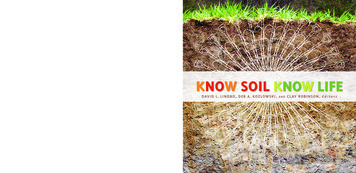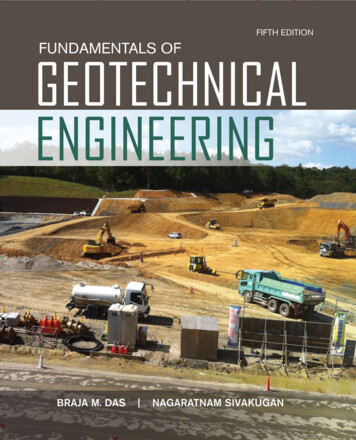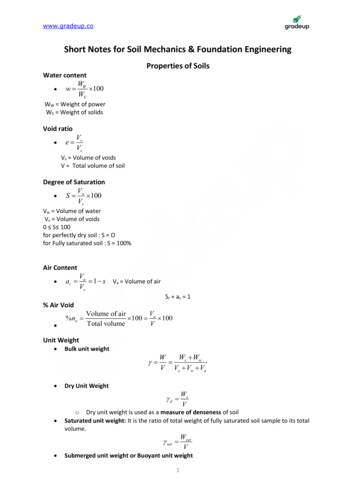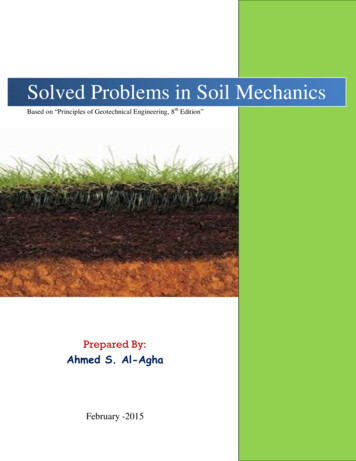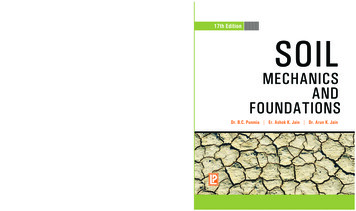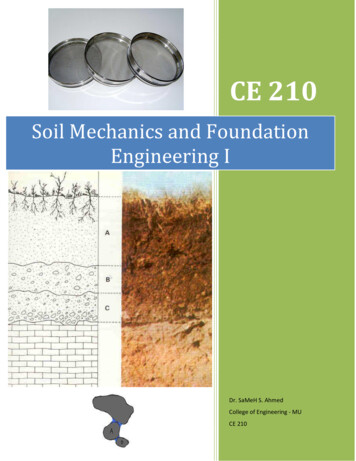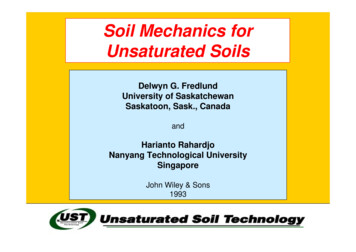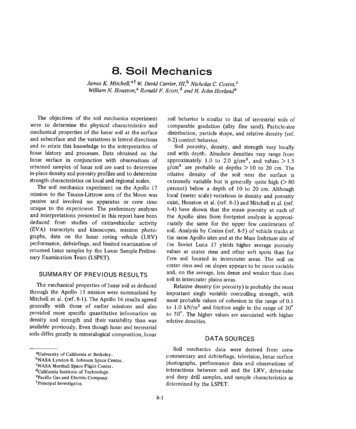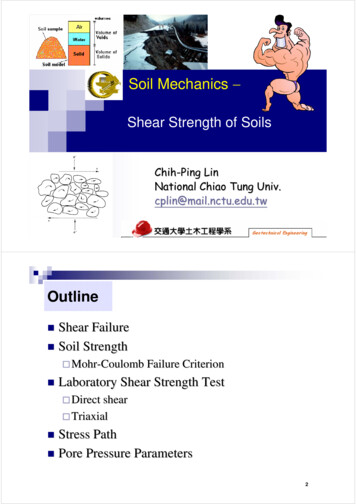
Transcription
Soil Mechanics Shear Strength of SoilsChih-Ping LinNational Chiao Tung Univ.cplin@mail.nctu.edu.tw1OutlineShear Failure Soil Strength Mohr-Coulomb Failure Criterion Laboratory Shear Strength TestDirect shearTriaxialStress Path Pore Pressure Parameters 2
Shear FailureShear failureSoils generally fail in shearembankmentstrip footingfailure surfacemobilised shearresistanceAt failure, shear stress along the failure surfacereaches the shear strength.3Shear FailureShear failurefailure surfaceThe soil grains slide overeach other along thefailure surface.No crushing ofindividual grains.4
Shear FailureShear failureσττAt failure, shear stress along the failure surface(τ) reaches the shear strength (τf).5Soil StrengthSoil (Shear) Strength Soils are essentially frictional materialsthe strength depends on the applied stress Strength is controlled by effective stresseswater pressures are required Soil strength depends on drainagedifferent strengths will be measured for a given soila)b)deforms at constant volume (undrained) anddeforms without developing excess pore pressures(drained)6
Mohr-CoulombMohr-Coulomb Failure Criterionττ f c' σ ' tan φ 'σ’τfailureφlopeevenfriction anglecohesionτfc’σ’σ’τf is the maximum shear stress the soil can takewithout failure, under normal stress of σ’.7Mohr-CoulombMohr-Coulomb Failure CriterionShear strength consists of twocomponents: cohesive and frictional.ττ f c' σ ' f tan φ 'τfφ’c’σ’f tan φcσ’fpco meviescohntonefrictionalcomponentσ’8
Mohr-Coulombc’ and φ’ are measures of shear strength.Higher the values, higher the shear strength.The parameters c’, φ’ depend on¾Soil composition¾Stress state of the soil (OCR)The Mohr-Coulomb criterion is an empirical criterion,and the failure locus is only locally linear.Extrapolation outside the range of normal stressesfor which it has been determined is likely to be unreliable.9Mohr-CoulombMohr Circles & Failure EnvelopeThe soil element does not fail ifthe Mohr circle is containedwithin the envelopeGL σ’σ’cσ’cYσ’cInitially, Mohr circle is a point σ’σ’c σ’10
Mohr-CoulombMohr Circles & Failure EnvelopeAs loading progresses, Mohrcircle becomes larger GL σ’σ’cσ’cYσ’c. and finally failure occurswhen Mohr circle touches theenvelope11Mohr-CoulombOrientation of Failure PlaneFailure planeoriented at 45 φ/2to horizontal (σ’1)Y45 φ’/2GL45 φ’/2 σ’σ’cσ’cYφ’90 φ’σ’cσ’c σ’12
Mohr-CoulombMohr circles in terms of σ & σ’σvXσv’σh uσh’X effective stressesσh’σv’ σhuXtotal stressesuσv13Mohr-CoulombEnvelopes in terms of σ & σ’Identical specimensinitially subjected todifferent isotropic stresses(σc) and then loadedaxially to failure σfσcσcσcσcufInitially At failure,σ3 σc; σ1 σc σfσ3’ σ3 – uf ; σ1’ σ1 - ufFailurec, φin terms of σc’, φ’in terms of σ’14
Mohr-CoulombEffective stress failure criterionIf the soil is at failure the effective stress failure criterion willalways be satisfied.τ c σ ′ tanφc′ and φ′ are known as the effective (or drained) strengthparameters.Soil behaviour is controlled by effective stresses, and theeffective strength parameters are the fundamental strengthparameters. But they are not necessarily soil constants.15Mohr-CoulombTotal stress failure criterionIf the soil is taken to failure at constant volume (undrained) then thefailure criterion can be written in terms of total stress asτ cu σ tanφucu and φu are known as the undrained strength parametersThese parameters are not soil constants, they depend strongly on themoisture content of the soil.The undrained strength is only relevant in practice to clayey soilsthat in the short term remain undrained. Note that as the porepressures are unknown for undrained loading the effective stressfailure criterion cannot be used.16
Shear Strength TestLaboratory Tests for Shear Strength ParametersDirect shear test Triaxial test Direct simple shear test Plane strain triaxial test Torsional ring shear test 17Direct ShearDirect Shear TestNormal loadTop platenLoad cell tomeasureShear ForceMotordriveSoilPorous platesRollersMeasurerelative horizontal displacement, dxvertical displacement of top platen, dy18
Direct ShearSand19Direct ShearClay20
Direct ShearPros: Simplest and most economical for sandy soil Applicable for soil/structure interfaceCons: Soil not allowed to fail along the weakest plane. Shear stress distribution is not uniform.21TriaxialTriaxial Test Apparatuspiston (to apply deviatoric stress)O-ringfailure planeimperviousmembranesoil sample atfailureporousstoneperspex cellwatercell pressureback pressurepore pressure orpedestalvolume change22
TriaxialTypes of Triaxial Testsdeviatoric stress ( σ)Under all-aroundcell pressure σcShearing(loading)Is the drainage valve open?yesIs the drainage valve open?yesnoConsolidatedUnconsolidated xialTypes of Triaxial TestsDepending on whether drainage is allowedor not during initial isotropic cell pressure application, and shearing,there are three special types of triaxial teststhat have practical significances. They are:Consolidated Drained (CD) testConsolidated Undrained (CU) testUnconsolidated Undrained (UU) test24
TriaxialFor unconsolidatedundrained test, interms of totalstresses, φu 0For normally consolidatedclays, c’ 0 & c 0.Granular soils haveno cohesion.c 0 & c’ 025TriaxialCD, CU and UU Triaxial TestsConsolidated Drained (CD) Test no excess pore pressure throughout the test very slow shearing to avoid build-up of porepressureCan be days! not desirable gives c’ and φ’Use c’ and φ’ for analysing fully drainedsituations (e.g., long term stability,very slow loading)26
TriaxialLoose sand / NC clayDense sand / OC Clay27Triaxial28
Triaxial29TriaxialCD, CU and UU Triaxial TestsConsolidated Undrained (CU) Test pore pressure develops during shearMeasure Î σ’ gives c’ and φ’ faster than CD ( preferred way to find c’ and φ’)30
TriaxialLoose sand / NC clayDense sand / OC Clay31Triaxial32
TriaxialCD, CU and UU Triaxial TestsUnconsolidated Undrained (UU) Test pore pressure develops during shear 0; i.e., failure envelopeNot measuredis horizontal σ’ unknown analyze in terms of σ Î gives cu and φu very quick testUse cu and φu for analysing undrainedsituations (e.g., short term stability,quick loading)33TriaxialUU test on saturated clay34
2001 Brooks/Cole, a division of Thomson Learning, Inc. Thomson Learning is a trademark used herein under license.TriaxialThe φ 0 concept35TriaxialUnconfined compression test on saturated clay36
Triaxialσ’1 and σ’3 at Failure37Stress PathStress PointσvσhXτtstress pointstress point(σv-σh)/2σv σσh(σv σh)/2t s σv σh2sσv σh238
Stress PathStress PathDuring loading τStress path isthe locus ofstress pointstStress pathσsStress path is a convenient way to keep track of theprogress in loading with respect to failure envelope.39Stress PathFailure Envelopesτtφfailuretan-1 (sin φ)c cos φcσstress pathsDuring loading (shearing) .40
Pore Pressure ParametersPore Pressure ParametersA simple way to estimate the porepressure change in undrainedloading, in terms of total stresschanges after Skempton (1954) σ1Y u B[ σ 3 A( σ 1 σ 3 )] σ3 u ?Skempton’s pore pressureparameters A and B41Pore Pressure ParametersPore Pressure ParametersB-parameterB f (saturation,.)For saturated soils, B 1.A-parameter at failure (Af)Af f(OCR)For normally consolidated clays Af 1.For heavily overconsolidated clays Af is negative.42
Soil behaviour is controlled by effective stresses, and the effective strength parameters are the fundamental strength parameters. But they are not necessarily soil constants. If the soil is at failure the effective stress failure criterion will always be satisfied. Mo

